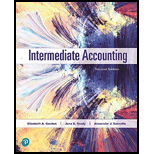
Intermediate Accounting (2nd Edition)
2nd Edition
ISBN: 9780134730370
Author: Elizabeth A. Gordon, Jana S. Raedy, Alexander J. Sannella
Publisher: PEARSON
expand_more
expand_more
format_list_bulleted
Textbook Question
Chapter 2, Problem 2.21BE
Assumptions in Financial Reporting. Indicate the assumption (going concern, business/economic entity, monetary unit, or periodicity) that best fits the following scenarios.
| Scenario | Related Assumption |
| a. Monro Manufacturing requires that its division managers report to corporate headquarters on a monthly basis. | |
| b. Rainbow Paints, Inc. owns 15% of New Eljam Company. Rainbow does not consolidate this affiliate company because it cannot control New Eljam’s operations. | |
| c. Financial analysts at Nelson Corporation use an infinite-growth assumption in building a model to value the company. | |
| d. Factory buildings are reported on Jack Jones Warehousing Inc.’s |
Expert Solution & Answer
Want to see the full answer?
Check out a sample textbook solution
Students have asked these similar questions
general accounting question
I need help with this general accounting question using the proper accounting approach.
I am trying to find the accurate solution to this general accounting problem with the correct explanation.
Chapter 2 Solutions
Intermediate Accounting (2nd Edition)
Ch. 2 - Prob. 2.1QCh. 2 - Prob. 2.2QCh. 2 - Why is a conceptual framework of accounting...Ch. 2 - Prob. 2.4QCh. 2 - Prob. 2.5QCh. 2 - Prob. 2.6QCh. 2 - Prob. 2.7QCh. 2 - What is predictive value?Ch. 2 - Prob. 2.9QCh. 2 - When is financial information considered...
Ch. 2 - Prob. 2.11QCh. 2 - Prob. 2.12QCh. 2 - Prob. 2.13QCh. 2 - What is the recognition principle and when is an...Ch. 2 - What is the revenue recognition principle and when...Ch. 2 - Prob. 2.16QCh. 2 - When are expenses recognized under IFRS?Ch. 2 - How are transactions recorded under accrual...Ch. 2 - Prob. 2.19QCh. 2 - Prob. 2.20QCh. 2 - Prob. 2.1BECh. 2 - Prob. 2.2BECh. 2 - Objective of Financial Reporting. Explain the...Ch. 2 - Prob. 2.4BECh. 2 - Fundamental and Enhancing Characteristics....Ch. 2 - Prob. 2.6BECh. 2 - Prob. 2.7BECh. 2 - Prob. 2.8BECh. 2 - Fundamental and Enhancing Characteristics....Ch. 2 - Faithful Representation. Match the component of a...Ch. 2 - Prob. 2.11BECh. 2 - Prob. 2.12BECh. 2 - Capital Maintenance Adjustments, IFRS. Describe...Ch. 2 - Expense Recognition. Discuss the three main...Ch. 2 - Element Definitions. Identify whether the...Ch. 2 - Prob. 2.16BECh. 2 - Element Definitions, U.S. GAAP, IFRS. Identify...Ch. 2 - Prob. 2.18BECh. 2 - Measurement Bases. Match the measurement basis...Ch. 2 - Cash versus Accrual Bases of Accounting. The...Ch. 2 - Assumptions in Financial Reporting. Indicate the...Ch. 2 - Conceptual Framework. Noeleen Auto Mall, Ltd....Ch. 2 - Qualitative Characteristics. Referring to the...Ch. 2 - Prob. 2.3ECh. 2 - Prob. 2.4ECh. 2 - Terms and Concepts. Complete the following...Ch. 2 - Prob. 2.6ECh. 2 - Cash versus Accrual Bases of Accounting. Top Notch...Ch. 2 - Cash vs. Accrual. you are provided the following...
Knowledge Booster
Learn more about
Need a deep-dive on the concept behind this application? Look no further. Learn more about this topic, accounting and related others by exploring similar questions and additional content below.Similar questions
- Please provide the answer to this general accounting question with proper steps.arrow_forwardI am looking for help with this general accounting question using proper accounting standards.arrow_forwardI am trying to find the accurate solution to this general accounting problem with the correct explanation.arrow_forward
arrow_back_ios
SEE MORE QUESTIONS
arrow_forward_ios
Recommended textbooks for you
 Managerial Accounting: The Cornerstone of Busines...AccountingISBN:9781337115773Author:Maryanne M. Mowen, Don R. Hansen, Dan L. HeitgerPublisher:Cengage Learning
Managerial Accounting: The Cornerstone of Busines...AccountingISBN:9781337115773Author:Maryanne M. Mowen, Don R. Hansen, Dan L. HeitgerPublisher:Cengage Learning EBK CONTEMPORARY FINANCIAL MANAGEMENTFinanceISBN:9781337514835Author:MOYERPublisher:CENGAGE LEARNING - CONSIGNMENT
EBK CONTEMPORARY FINANCIAL MANAGEMENTFinanceISBN:9781337514835Author:MOYERPublisher:CENGAGE LEARNING - CONSIGNMENT Principles of Cost AccountingAccountingISBN:9781305087408Author:Edward J. Vanderbeck, Maria R. MitchellPublisher:Cengage LearningPrinciples of Accounting Volume 2AccountingISBN:9781947172609Author:OpenStaxPublisher:OpenStax College
Principles of Cost AccountingAccountingISBN:9781305087408Author:Edward J. Vanderbeck, Maria R. MitchellPublisher:Cengage LearningPrinciples of Accounting Volume 2AccountingISBN:9781947172609Author:OpenStaxPublisher:OpenStax College Intermediate Accounting: Reporting And AnalysisAccountingISBN:9781337788281Author:James M. Wahlen, Jefferson P. Jones, Donald PagachPublisher:Cengage Learning
Intermediate Accounting: Reporting And AnalysisAccountingISBN:9781337788281Author:James M. Wahlen, Jefferson P. Jones, Donald PagachPublisher:Cengage Learning

Managerial Accounting: The Cornerstone of Busines...
Accounting
ISBN:9781337115773
Author:Maryanne M. Mowen, Don R. Hansen, Dan L. Heitger
Publisher:Cengage Learning


EBK CONTEMPORARY FINANCIAL MANAGEMENT
Finance
ISBN:9781337514835
Author:MOYER
Publisher:CENGAGE LEARNING - CONSIGNMENT

Principles of Cost Accounting
Accounting
ISBN:9781305087408
Author:Edward J. Vanderbeck, Maria R. Mitchell
Publisher:Cengage Learning

Principles of Accounting Volume 2
Accounting
ISBN:9781947172609
Author:OpenStax
Publisher:OpenStax College

Intermediate Accounting: Reporting And Analysis
Accounting
ISBN:9781337788281
Author:James M. Wahlen, Jefferson P. Jones, Donald Pagach
Publisher:Cengage Learning
Financial ratio analysis; Author: The Finance Storyteller;https://www.youtube.com/watch?v=MTq7HuvoGck;License: Standard Youtube License